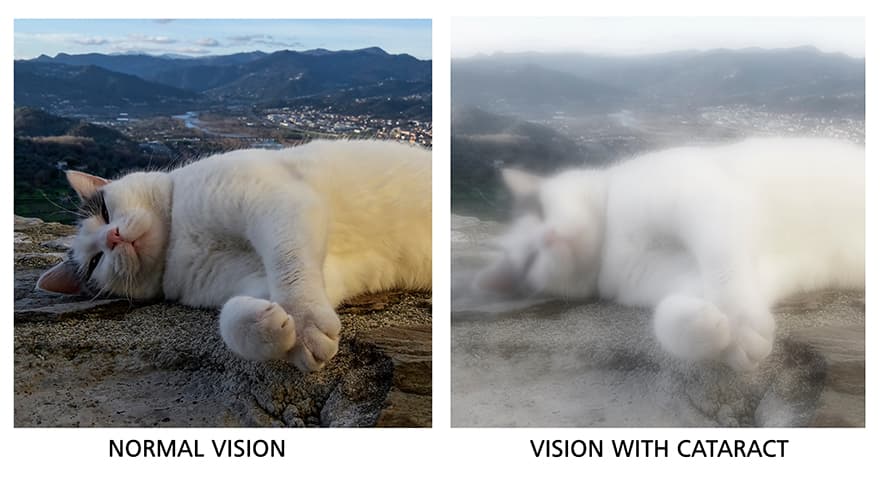Cataract surgery is an operation to remove your eye’s lens when it is cloudy.

The purpose of your lens is to bend (refract) light rays that come into the eye to help you see. Your own lens should be clear, but with a cataract it is cloudy. Having a cataract can be like looking through a foggy or dusty car windshield. Things may look blurry, hazy or less colorful.
The only way to remove a cataract is with surgery. Your ophthalmologist will recommend removing a cataract when it keeps you from doing things you want or need to do.

During cataract surgery, your cloudy natural lens is removed and replaced with a clear artificial lens. That lens is called an intraocular lens (IOL). Your ophthalmologist will talk with you about IOLs and how they work.
What to Expect with Cataract Surgery
Before surgery

Your surgeon will measure your eye to determine the proper focusing power for your IOL. Also, you will be asked about any medicines you take. You might be asked not to take some of these medicines before surgery.
You may be prescribed eyedrop medicines to start before surgery. These medicines help prevent infection and reduce swelling during and after surgery.
The day of surgery
Your ophthalmologist may ask you not to eat any solid food at least 6 hours before your surgery. Cataract removal surgery may be done in an outpatient surgery center or in a hospital.
Here is what will happen:
- Your eye will be numbed with eye drops or with an injection around the eye. You may also be given medicine to help you relax.
- You will be awake during surgery. You may see light and movement during the procedure, but you will not see what the doctor is doing to your eye
- Your surgeon looks through a special microscope. She creates tiny incisions (cuts, created by laser or a blade) near the edge of your cornea. The surgeon uses these incisions to reach the lens in your eye. Using very small instruments, he or she will break up the lens with the cataract and remove it. Then she puts your new lens into place.
- Usually your surgeon will not need to stitch the incisions closed. These “self-sealing” incisions eventually will close by themselves over time. A shield will be placed over your eye to protect it while you heal from surgery.
- You will rest in a recovery area for about 15–30 minutes. Then you will be ready to go home.
Cataract Surgery Recovery
Days or weeks after surgery:

- You will have to use eye drops after surgery. Be sure to follow your doctor’s directions for using these drops.
- Avoid getting soap or water directly in the eye.
- Do not rub or press on your eye. Your ophthalmologist may ask you to wear eyeglasses or a shield to protect your eye.
- You will need to wear a protective eye shield when you sleep.
- Your ophthalmologist will talk with you about how active you can be soon after surgery. He or she will tell you when you can safely exercise, drive or do other activities again.
What Are the Risks of Cataract Surgery?
Like any surgery, cataract surgery carries risks of problems or complications.
Here are some of those risks:
- Eye infection.
- Bleeding in the eye.
- Ongoing swelling of the front of the eye or inside of the eye.
- Swelling of the retina (the nerve layer at the back of your eye).
- Detached retina (when the retina lifts up from the back of the eye).
- Damage to other parts of your eye.
- Pain that does not get better with over-the-counter medicine.
- Vision loss.
- The IOL implant may become dislocated, moving out of position.
Cataract surgery will not restore vision lost from other eye conditions such as macular degeneration, glaucoma, or diabetic retinopathy. Your ophthalmologist will talk with you about the risks and benefits of cataract surgery.
Posterior Capsular Opacification
Your vision could become cloudy or blurry weeks, months or years after cataract surgery. This is not unusual. Your doctor might call this a “posterior capsular opacification (or PCO).” It’s also called “secondary cataract” or “scar tissue.” It’s not like a scar you get on your skin. But because it happens after the eye has healed from cataract surgery, some people think of it as a scar. It happens when a membrane called the posterior capsule becomes cloudy. It might help to think of the posterior capsule as a transparent pocket. It holds your IOL in place. It also once held your eye’s natural lens (what became the cataract) in place. If you notice cloudy vision again, you might need to have a laser procedure. The laser creates an opening in the cloudy capsule and is called a posterior capsulotomy (or a YAG laser capsulotomy). This procedure helps restore clear vision.
Cataract Surgery Costs
Cataract surgery costs are generally covered by Medicare if you are Medicare eligible. Private insurance usually covers cataract surgery as well.
Medicare will cover your costs if your vision tests at a certain level of acuity or clarity. Private insurance plans may have similar vision requirements. If your surgery is covered you may still have some costs. Special types of IOLs will cost more. Choosing to have cataract surgery before your vision has deteriorated enough will cost more.
In certain cases, it might be possible to get coverage before you meet the age or vision requirements. Talk with your ophthalmologist if you are considering having early cataract surgery.
What do you do if you don’t have Medicare or private insurance coverage? You may still be able to reduce and manage the cost of cataract surgery. Ask about payment plans through your doctor’s office. See if your employer offers flexible spending accounts that can help. Your ophthalmologist can help you learn more about costs of cataract surgery. Discuss your options for affording the procedure.
Traditional Cataract Surgery vs. Laser-Assisted Cataract Surgery: Which one is right for you?
Are you planning to have cataract surgery? If so, you may have two surgical options:
- Traditional cataract surgery
- laser-assisted cataract surgery
Traditional cataract surgery is one of the most common surgeries in the world. It is recognized as being safe and effective. Laser cataract surgery is not covered by most insurance plans. It costs more than traditional cataract surgery as well. In specific situations, it may provide some advantages. So how do you decide which type of cataract surgery to have?
Here are some things you should understand about both kinds of cataract surgery. Talk with your ophthalmologist about which is best for you. Feel free to get another eye surgeon’s opinion as well.
How is traditional cataract surgery done?
Phacoemulsification is the name for traditional cataract surgery. Your surgeon creates a small incision in your cornea by hand with a scalpel. They insert a small instrument through this opening. It goes behind your pupil where the eye’s lens sits in a capsule. Your surgeon creates a round opening in the capsule. Then your surgeon inserts a pen-shaped probe through that opening. The probe applies sound waves (ultrasound) to break up the cloudy lens. Then the surgeon suctions out the broken-up pieces. They replace your lens with an artificial intraocular lens (IOL) The surgeon closes the incision with a special liquid and self-seal. Stitches are commonly not needed.
How is laser-assisted cataract surgery done?
A camera/ultrasound device is placed over your eye to map its surface. It also gathers information about your lens. The device sends the results to a computer that programs the laser. This tells the laser the exact location, size, and depth for incisions. The surgeon uses the laser to make the corneal incision and the opening in the capsule. They may also use energy from the laser to soften the cataract. An ultrasound probe breaks the lens into pieces and suctions them out. The surgeon then puts the IOL in the eye. Again, the incision usually does not need stitches.
To whom can ophthalmologists offer laser-assisted cataract surgery?
Medicare guidelines determine who can get this laser surgery. Only certain patients qualify for it.
Your surgeon can offer laser-assisted cataract surgery if:
- they find astigmatism during your consultation, and
- you want it corrected during cataract surgery
In this situation, the laser creates specific incisions in the cornea to reshape it. This corrects your astigmatism. Your surgeon can also offer laser surgery if you choose a premium lens. For example, this may be a toric or multifocal IOL that corrects astigmatism. Laser cataract removal allows surgeons to see and map the lens capsule better. It also helps them to place the opening in the capsule more precisely. This allows for better centering of the IOL.
Can you have laser cataract surgery if you don’t meet the conditions?
If you don’t meet at least one condition, a surgeon cannot offer or charge for laser surgery.
Which type of cataract surgery has a shorter recovery time?
The recovery time for both types of surgery is the same. Some people can see clearly almost immediately. Others may find their vision clears within a week or two. It takes about 3 months to fully recover from cataract surgery.
What benefits does laser cataract surgery offer?
Using a laser allows the surgeon to make precise incisions in less time. It can improve accuracy and consistency. In some cases, the laser can provide more correction than traditional surgery.
However, studies do not show that laser surgery results in fewer complications. Also, studies haven’t found that laser surgery provides better outcomes. Your outcome depends in large part on the skill and experience of your surgeon.
What do you want from cataract surgery?
Replacing a cloudy lens and wearing glasses for some things is perfect for many people. For others, getting the best possible vision without glasses is the goal. You and your surgeon can decide the best option for you based on your needs.



